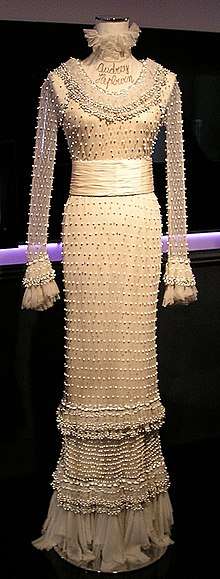Fashion activism
Fashion activism is the practice of using fashion as a means of social change. It merges popular styles of dress, from clothing and shoes, to headwear and accessories, with efforts to implement social and political change. Fashion activism can be used as a form of protest, whether expressing dissent or support.
The term 'fashion activism' was coined by designer Céline Semaan. The New York based founder of the design and tech lab Slow Factory has used key items in her collections as means of fashion activism; a 'Dignity Key' necklace with which people can show support for displaced Middle Eastern refugees, a 'Banned' scarf showing the universal impact of President Trump's Muslim ban, and a '1st Amendment Flight Jacket' collaboration with ACLU, featuring the First Amendment text written in Arabic, standing up to the rise in islamophobia in the United States and hate crimes against American Muslims.
Other examples of fashion activism range from apparel with peace sign symbols that were popularized in the mid-1900s, to the 'Make America Great Again' hats sported by Donald Trump supporters throughout and following the 2016 presidential campaign.
Fashion Design Items That Influenced Socio-Political Events
The Mini Skirt
The mini skirt made its debut in 1964 and quickly became a bastion of youth culture and defiance[1]. Mary Quant, the London-based designer responsible for the skirt, sought to reflect an era that was “arrogant, aggressive, and sexy.”[2] Accordingly, the mini skirt was a popular choice for independent and progressive women in the 1960s. During the violent protests and events of May 1968 in France, the mini skirt became a symbol of female revolution and defiance. Andre Courrèges popularized the hemline in France. While the nostalgia of the 1970s saw a return to more conventional hemlines, the mini skirt persists as a symbol of women’s rights and sexual liberation to this day.
The Slogan T-Shirt
The slogan T-shirt has been favored by activists since its inception. Fueled by the DIY ethos of the punk era, Vivienne Westwood’s subversive t-shirt designs brought the slogan aesthetic into the mainstream in the 1970s. In 1979, designer Katharine Hamnett launched a label and line of shirts driven by the concept of ‘right livelihood;’ the shirt slogans were based on the central messages of Buddhism. The T-shirts were “designed to be seminal, to make people think, and then hopefully act,” Hamnett said in an interview.[3] In recent years, slogan tees have become a staple in popular culture, from runways to stadiums. British designer Daniel W. Fletcher organized an anti-Brexit sit-in with protesters wearing “stay” shirts and hoodies. Many prominent designers and labels such as Dior, Public School, Everlane, and Slow Factory have produced slogans supporting women’s rights, gay rights, immigrants, refugees, and conservation efforts.
The Keffiyeh
The Keffiyeh is a traditional black and white scarf worn around the head or neck. According to design critic Hala Malak, the Keffiyeh dates back to pre-Islamic Sumer. High priests would wear turbans and fishing nets when praying for prosperous fishing seasons; the integration of these two textiles eventually led to the classic fishnet pattern the Keffiyeh is known for. Following the 1936 Arab Revolt, the Keffiyeh became a symbol of political uprising and rebellion. It was not until the rise of Arafat in the 1960s that the scarf came to symbolize Palestinian solidarity. The scarf has appeared among many leftist groups and anti-war organizations. The scarf was appropriated as a fashion accessory in a 2007 Balenciaga show. The Keffiyeh is a fashion staple in the west, although few are aware of its rich political history.[4] Today, the Kaflab Foundation works with artists and designers to explore and destigmatize Arab heritage and identity through the Keffiyeh.
References
- Bourne, L. (2014, September 22). A History of the Miniskirt: How Fashion’s Most Daring Hemline Came To Be. Retrieved July 14, 2017, from http://stylecaster.com/history-of-the-miniskirt/
- Parks, C. (2015, March 23). The Miniskirt: An Evolution From The '60s To Now. Retrieved July 14, 2017, from http://www.huffingtonpost.com/2015/03/23/mini-skirt-evolution_n_6894040.html
- Interview with Ethical Designer Katharine Hamnett. (2013, November 21). Retrieved July 14, 2017, from http://www.thefashionspot.com/runway-news/351665-katharine-hamnett-interview/
- Kim, K. (2007, February 10). Where Some See Fashion, Others See Politics. Retrieved July 14, 2017, from https://www.nytimes.com/2007/02/11/fashion/shows/11KAFFIYEH.html
- Safronova, Valeriya (5 April 2017). "Refugee Designer Shines a Light on Global Issues". The New York Times. The New York Times. Retrieved 7 June 2017.
- "We're at Slow Factory, a fashion-activism company in Brooklyn.."". The New York Times. The New York Times Style. Retrieved 7 June 2017.
- Semaan, Céline. "Slow Factory's Collection Is a Direct Shot at Donald Trump's Muslim Ban". Teen Vogue. Teen Vogue. Retrieved 7 June 2017.
- Colon, Ana. "The Powerful Message Behind These "Banned" Scarves". Refinery 29. Refinery 29. Retrieved 7 June 2017.
- Puhala, Kate. "NASA Satellite Images Take These Scarves to Infinity… and Beyond!". Brit + Co. Brit + Co. Retrieved 7 June 2017.
